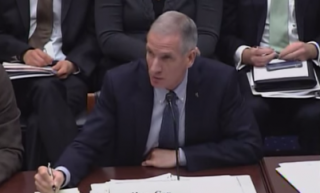
committee Tuesday.
(Screen capture via Rep. Rick Larsen)
Vision Zero is maybe the hottest subject in American street advocacy right now, but there’s still quite a lot of disagreement about what exactly it means.
As Portland adopts an official policy to prevent all road deaths and safety advocates begin a push for state and other local governments to follow that lead, we’ve just gotten a couple very clear examples of what Vision Zero doesn’t mean.
One comes from a hearing Tuesday in Washington D.C. The other comes from a state engineer quoted yesterday in The Oregonian.
As reported by Streetsblog USA, the president of the country’s most influential road-design organization answered a question about the recent national uptick in the number of people dying on bikes or foot by saying that on rural roads in his home state of Wyoming, road design is not an issue.
“Behavior — driver behavior and cyclist behavior — was really 100 percent the issue, not the design of the pavement,” Jon Cox, president of the American Association of State Highway and Transportation Officials, said in a congressional hearing.
Cox didn’t elaborate on any possible policy changes, rural or otherwise.
Advertisement
Then, yesterday on OregonLive.com, Oregon Department of Transportation traffic engineering unit manager Doug Bish expressed a similar (though not identical) view while describing the agency’s safety efforts.
The state analyzes highways a tenth of a mile at a time and looks for places “where there is a higher number than normal of crashes going on.”
He said that fatal accidents, on their own, don’t necessarily indicate an engineering problem because many of them are the result of driver behavior rather than problems with roads or highways.
“If five crashes occur at a location,” he said, “there’s a stronger possibility that something is wrong rather than one crash where five people die.”
Obviously neither Cox or Bish is in favor of road deaths. But do they tolerate road deaths? Bish explicitly does. And neither Cox (a law enforcement officer by trade) or Bish (an engineer) seems to be open to the concept that roads designed for speed are a primary factor behind drivers’ unsafe behavior.
If they’d been pushed on the issue, Cox and Bish might have said that although safety improvements are important, allowing the overwhelming majority of cars to move quickly down a road is more important than preventing thousands of bad decisions from turning into fatalities every year across the country.
That argument might be valid. But it’s one that American politicians and engineering officials aren’t currently forced to make. If Vision Zero can accomplish anything, maybe it’s getting people to say this out loud — and decide for themselves whether they can live with the ongoing consequences.


